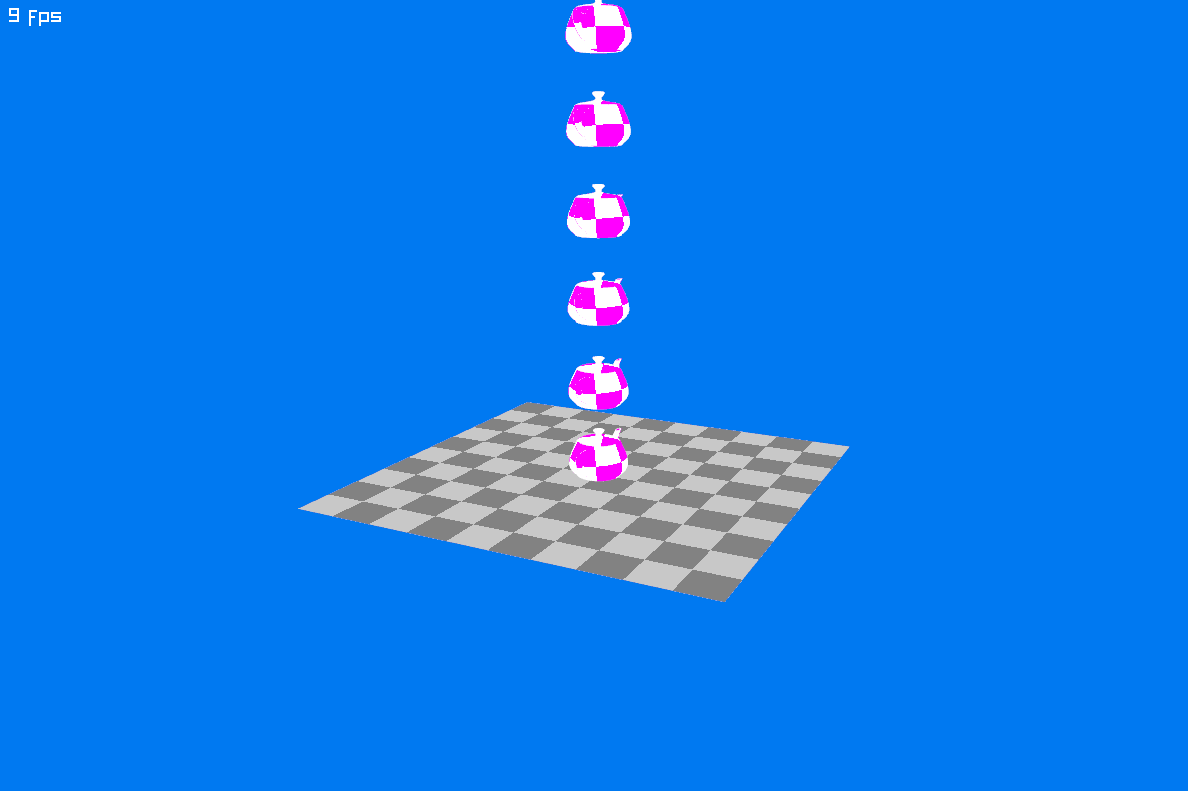Hello World
Creating the PointCloudShape
We can now create a PointCloudShape from the sampled vertices:
// find a few points on the convex hull of the teapot.
var vertices = ShapeHelper.SampleHull(allVertices, subdivisions: 3);
// use these points to create a PointCloudShape.
var pointCloudShape = new PointCloudShape(vertices);
However, we need to be a bit careful here.
If we add this shape to a rigid body as-is, the body may not behave as intuitively expected.
This is because the center of mass of a rigid body is always located at (0, 0, 0) in its local coordinate frame.
If you open teapot.obj in a model editor, you'll notice that the model is not centered around the origin.
To correct this, we either need to center the model manually in a model editor—or, more conveniently, use the Shift property of PointCloudShape to align the center of mass with the origin:
// find a few points on the convex hull of the teapot.
var vertices = ShapeHelper.SampleHull(allVertices, subdivisions: 3);
// use these points to create a PointCloudShape.
var pointCloudShape = new PointCloudShape(vertices);
// shift the shape so its center of mass is at the origin.
pointCloudShape.GetCenter(out JVector centerOfMass);
pointCloudShape.Shift = -centerOfMass;
// pointCloudShape.GetCenter(out centerOfMass); // now returns (0, 0, 0)
// finally, create the rigid body for the teapot
var rigidBody = world.CreateRigidBody();
rigidBody.AddShape(pointCloudShape);
The shift applied to the shape must also be taken into account when rendering the model, to ensure it aligns visually with the simulation.
Creating Multiple Instances of the Same Shape
In Jitter, it is not valid to add the same shape instance to multiple rigid bodies.
To create additional instances of a shape, use the Clone() method of PointCloudShape.
This method creates a new shape object that shares the underlying data structure, saving both memory and computation time:
var shapeInstance1 = new PointCloudShape(vertices);
var shapeInstance2 = shapeInstance1.Clone(); // Safe to use in a second body
This approach is especially useful when many bodies share the same geometry, such as multiple identical props or characters in a simulation.
Putting it all together
using System.Numerics;
using Raylib_cs;
using Jitter2;
using Jitter2.Collision.Shapes;
using Jitter2.Dynamics;
using Jitter2.LinearMath;
using static Raylib_cs.Raylib;
static Matrix4x4 GetRayLibTransformMatrix(RigidBody body)
{
JMatrix ori = JMatrix.CreateFromQuaternion(body.Orientation);
JVector pos = body.Position;
return new Matrix4x4(ori.M11, ori.M12, ori.M13, pos.X,
ori.M21, ori.M22, ori.M23, pos.Y,
ori.M31, ori.M32, ori.M33, pos.Z,
0, 0, 0, 1.0f);
}
static Texture2D GenCheckedTexture(int size, int checks, Color colorA, Color colorB)
{
Image imageMag = GenImageChecked(size, size, checks, checks, colorA, colorB);
Texture2D textureMag = LoadTextureFromImage(imageMag);
UnloadImage(imageMag);
return textureMag;
}
const int numberOfTeapots = 12;
// set a hint for anti-aliasing
SetConfigFlags(ConfigFlags.Msaa4xHint);
// initialize a 1200x800 px window with a title
InitWindow(1200, 800, "TeaDrop example");
// dynamically create a plane model
Texture2D texture = GenCheckedTexture(10, 1, Color.LightGray, Color.Gray);
Model planeModel = LoadModelFromMesh(GenMeshPlane(20, 20, 10, 10));
SetMaterialTexture(ref planeModel, 0, MaterialMapIndex.Diffuse, ref texture);
// load the teapot model from file
Model teapotModel = LoadModel("teapot.obj");
// load the mesh vertices
if (teapotModel.MeshCount == 0)
throw new Exception("Model could not be loaded!");
Mesh teapotMesh;
unsafe { teapotMesh = teapotModel.Meshes[0]; }
var allVertices = teapotMesh.VerticesAs<JVector>();
// sample vertices on the convex hull
var vertices = ShapeHelper.SampleHull(allVertices.ToArray(), 4);
// create the PointCloudShape from the reduced vertices
var pointCloudShape = new PointCloudShape(vertices);
// shift the shape, such that the center of mass is at the origin
pointCloudShape.GetCenter(out JVector center);
pointCloudShape.Shift = -center;
// we need to take the transpose here, since Raylib and System.Numerics
// use a different convention
Matrix4x4 shift = Matrix4x4.CreateTranslation(-center);
shift = Matrix4x4.Transpose(shift);
texture = GenCheckedTexture(16, 2, Color.White, Color.Magenta);
Material teapotMat = LoadMaterialDefault();
SetMaterialTexture(ref teapotMat, MaterialMapIndex.Diffuse, texture);
// initialize the Jitter physics world
World world = new ();
world.SubstepCount = 4;
// add a body representing the plane
RigidBody planeBody = world.CreateRigidBody();
planeBody.AddShape(new BoxShape(20));
planeBody.Position = new JVector(0, -10, 0);
planeBody.MotionType = MotionType.Static;
// add numberOfTeapots teapots
for(int i = 0; i < numberOfTeapots; i++)
{
RigidBody body = world.CreateRigidBody();
body.AddShape(pointCloudShape.Clone());
body.Position = new JVector(0, i * 4 + 0.5f, 0);
}
// create a camera
Camera3D camera = new ()
{
Position = new Vector3(-40.0f, 16.0f, 20.0f),
Target = new Vector3(0.0f, 4.0f, 0.0f),
Up = new Vector3(0.0f, 1.0f, 0.0f),
FovY = 45.0f,
Projection = CameraProjection.Perspective
};
// 100 fps target
SetTargetFPS(100);
// simple render loop
while (!WindowShouldClose())
{
BeginDrawing();
ClearBackground(Color.Blue);
BeginMode3D(camera);
DrawModel(planeModel, Vector3.Zero, 1.0f, Color.White);
world.Step(1.0f / 100.0f, true);
foreach(var body in world.RigidBodies)
{
if (body == planeBody || body == world.NullBody) continue; // do not draw this
DrawMesh(teapotMesh, teapotMat, GetRayLibTransformMatrix(body) * shift);
}
EndMode3D();
DrawText($"{GetFPS()} fps", 10, 10, 20, Color.White);
EndDrawing();
}
CloseWindow();
